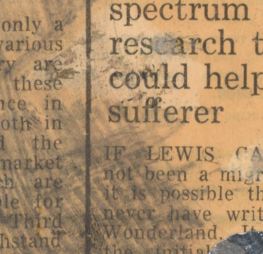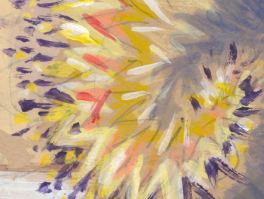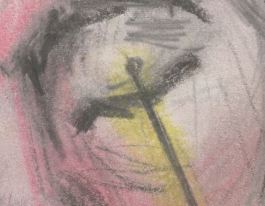Migraine Action is the national advisory and support charity for people affected by migraine, and is based just down the road from me in Leicester, UK. It provides support to individuals, families, businesses, medical professionals and support workers, with the aim to help sufferers to take control of their migraine and reduce its impact in their home life and in the workplace.
Migraine Action also holds a remarkable archive of around 550 original pieces of artwork which were produced by members of the public for four Migraine Art Competitions held between 1980 and 1987. Entrants were invited to illustrate their own impressions of visual disturbance or the effect migraine has on their everyday lives. The collection represents the work of around 450 artists, of whom three-quarters were women, and one in ten were children aged 16 and under.
Since the beginning of my project, I have wanted to include the art collection as a chapter in my book. While neurologists have considered the depictions of aura in these works to be useful in understanding something about the mechanisms of migraine, they have also dismissed the significance of the depictions of pain and lived experience. This seems wrong to me. Individually and collectively the artworks in the collection provide a vivid insight into life with pain and illness. Aesthetically many pieces of work – the hairstyles, the airbrushing, the net curtains, the cultural references – are very much a product of the 1980s, but the concerns represented by these artists often appear to be timeless. Depictions of daggers, hammers, flashing lights, pulsing veins, flames, social isolation, are as relevant now, as they were to the people who talked of migraine in the fifteenth or seventeenth centuries. But it is the images by children that I found most moving, and difficult to look at. I often wonder how a parent must have felt, after urging their child to draw a picture for the competition, but then having to see the results – their child’s view of pain, isolation and unhappiness.
As I have been working in the Migraine Action offices on my research, we have often wondered about how we could make this important collection more accessible to the public. The opportunity came earlier this year, when we successfully bid for funding from the University of Leicester REF Impact Development Fund, which aims to help researchers develop the public impact of their work.
The grant we were awarded has enabled us to employ a Research Assistant to catalogue and scan the collection, and to commission the Leicester-based social-enterprise design and communications agency We Are Epic to create a website which will give free public access to the entire collection.
The project began in earnest in early March, and the first task for Dr Steve Ling, our Rese
 arch Associate, was to catalogue the entire collection. One of the most important aspects of this cataloguing has been the ‘tagging’ of images with keywords that will transfer to the website as search terms. Steve is now well into the high-resolution scanning. Seeing these images at such a large scale on the screen is wonderful, revealing the detail of every brushstroke and pen line.
arch Associate, was to catalogue the entire collection. One of the most important aspects of this cataloguing has been the ‘tagging’ of images with keywords that will transfer to the website as search terms. Steve is now well into the high-resolution scanning. Seeing these images at such a large scale on the screen is wonderful, revealing the detail of every brushstroke and pen line.
 Meanwhile, We Are Epic have been working hard on the website design. I am so excited about the ways that people will be able to search for images by theme and keyword. The website will be completed over the summer, and we hope to launch during Migraine Awareness week in September.
Meanwhile, We Are Epic have been working hard on the website design. I am so excited about the ways that people will be able to search for images by theme and keyword. The website will be completed over the summer, and we hope to launch during Migraine Awareness week in September.
The historian’s research process is a long one, and it can be years before our results appear in print. This project has happened fast. It’s been so exciting to work with such an enthusiastic team on something that has such a clear and simple purpose. I can’t wait to share it with you all. More soon!

